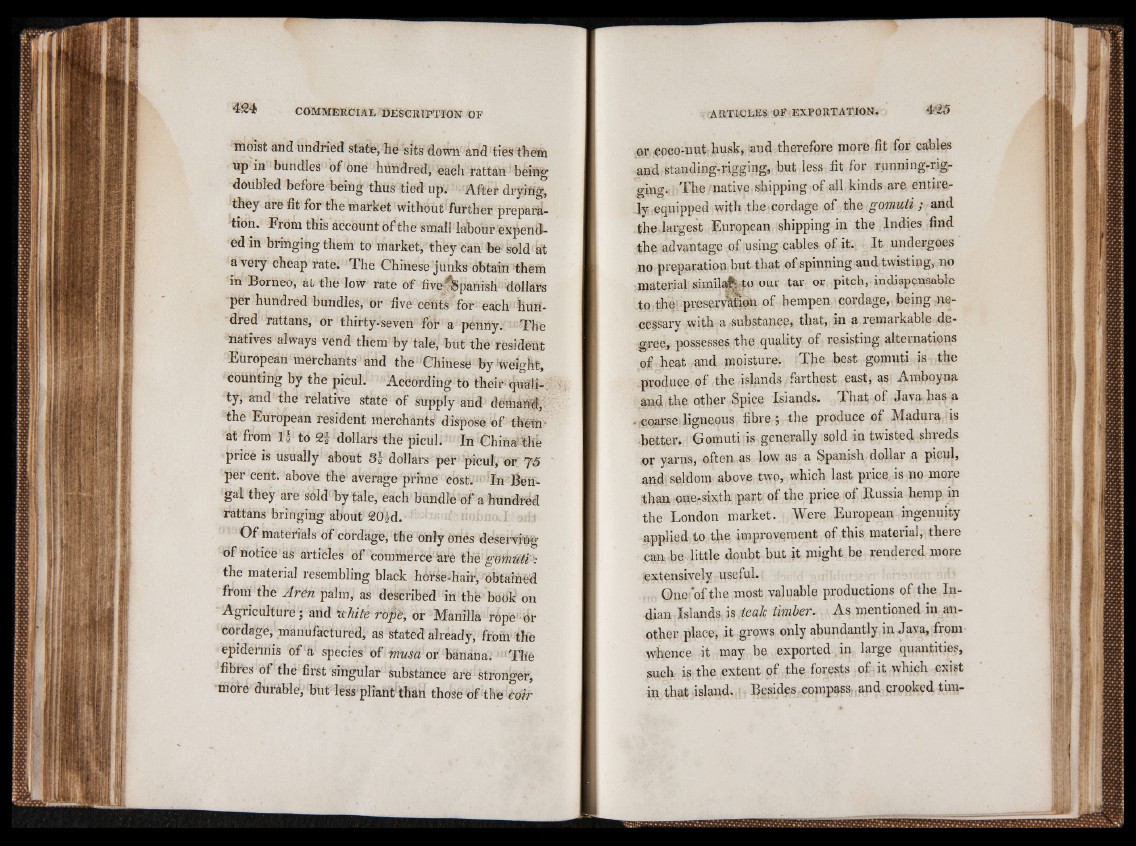
moist and undried state, he sits down and ties them
up in bundles of one hundred, each rattan being
doubled before being thus tied up;! After drying,
they are fit for the market without further preparation.
From this account of the small labour expended
in bringing them to market, they can be sold at
a very cheap rate. The Chinese junks obtain them
in Borneo, at the low rate of five^panish dollars
per hundred bundles, or five cents for each hundred
rattans, or thirty-seven for a penny. The
natives always vend them by tale, but the resident
European merchants ’ and the Chinese by Weight,
counting by the picul. According to their' quality,
and the relative state of supply and deihartd,
the European resident merchants dispose of theln-
at from li to dollars the picul. In China''the
price is usually about 3j dollars per picul, or J5
per cent, above the average prime cost;*'1 In Bengal
they are sold by tale, each bundle of a hundred
rattans bringing about 20‘M. !
O f materials of cordage, the only ones deserving
of notice as articles of commerce are the gomuti':
the material resembling black horse-hair, obtained
from the Ar&n palm, as described in the book on
Agriculture; and white rope, or Manilla rope <Jr
cordage, manufactured, as stated already, from the
epidermis of a species of musa or banana. Tlie
fibres of the first singular substance are stronger,
more durable, but less pliant than those of the coir
or coco-nut husk, and therefore more fit for cables
and standing-rigging, but less fit for running-rigging.
The native shipping of all kinds are entirely
equipped with the cordage of the gomuti; and
the. largest European shipping in the Indies find
the advantage of using cables of it. It undergoes
no preparation but that of spinning and twisting, no
material similaf* t° our tar or pitch, indispensable
to the preservation of hempen cordage, being necessary
with a substance, that, in a remarkable degree,
possesses the quality of resisting alternations
of heat and moisture. The best gomuti is the
produce of the islands. farthest east, as Amboyna
and the other Spice Islands. That of Java has a
. coarse ligneous fibre; the produce of Madura is
better. Gomuti is generally sold in twisted shreds
or yarns, often as low as a Spanish dollar a picul,
and seldom above two, which last price is no more
than one-sixth part of the price of Russia hemp in
the London market. Were European ingenuity
applied to the improvement of this material, there
can be little doubt but it might be rendered more
extensively useful.
One of the most valuable productions of the Indian
Islands is teak timber. As mentioned in another
place, it grows only abundantly in Java, from
whence it may be exported in large quantities,
such is the extent of the forests of it which exist
in that island. Besides compass,,and crooked tim